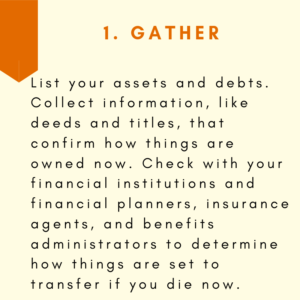
09 Jan Step 1 For Efficient Estate Planning: Gather
In over ten years of walking people through the legal to do list that comes up when someone dies, I’ve seen a pattern. The people who leave a manageable to do list when they die have gone through various steps, even though they maybe didn’t realize it at the time. The first step? Understand what they have.
STEP 1 – GATHER
Okay. Don’t get overwhelmed. You don’t need to inventory everything you have. But, for the significant things, usually things that have documents, we need to understand they exist and how they’re going to transfer when you die. Gather up those documents. The point is that you see what you have and see where it will go.

How do you own your house? For real estate, we’re looking for deeds. If you’re a couple, does it list both of you? Does the deed list you both in the way that means the survivor gets it all? Who is listed as the beneficiary on your life insurance and retirement accounts? Who’s on the car title?
Does that seem a bit overwhelming? It might. But it’s important to take this step. No matter how complicated it may seem for you to gather the information now, imagine what that will be like for someone to do after you’re gone. All while going through the emotions of losing you. See how this works?
Knowing what you have and knowing how it transfers today will help you understand the to do list that someone else will eventually deal with. Then you can start simplifying any complications you can see now.

This is the most important step. Understanding what you have can help when it comes time to make the documents. More importantly, it can help you avoid preventable issues. For example, let’s say you’re married and you buy a house. And let’s say that the deed either only has your name on it or it has both your names, but in a way that the survivor doesn’t get it all automatically when someone dies. If you don’t catch it and make a change, your spouse, in addition to grieving you, will also have to go through court process so that they can sign a deed to themselves in order to sell or even refinance it. A court process that could have been easily avoided.
If you gather your information, like deeds, you can go through what would happen if you died that moment and Deeds usually take a lawyer to look at and make a deed to fix an issue. But you can pull your car title and go to the DMV, or confirm ownership of bank accounts through the bank.
Asset ownership sets what that legal to do list looks like. Good planning, the type of thinking ahead that anticipates that to do list, takes understanding the ownership.
So. I have something to help you do just that. A free downloadable checklist to help you identify your assets and gather the information you (and your estate planner) will need to anticipate the to do list you’ll leave when you die.




Pingback:Step 2 For Efficient Estate Planning: Check In – An Organized (after)Life
Posted at 21:18h, 29 January[…] have you done it? Have you gathered your information about what you own? If you haven’t. That’s OKAY. If you haven’t […]
Pingback:The Worst Treasure Hunts – An Organized (after)Life
Posted at 12:53h, 07 February[…] why Step 1 – Gather, is so important. Not only do you need to have some idea of what you own when trying to reduce the […]